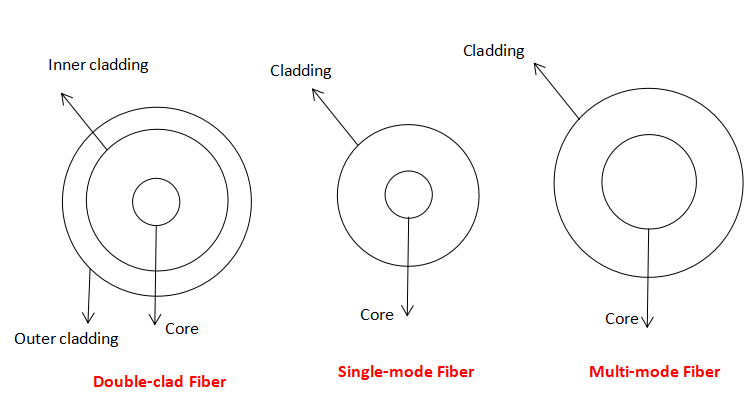Lightrun Popularization: Fiber Combiners
Precise Classification System to Match Different Scenarios
A fiber combiner is a key passive component used in all-fiber laser amplifiers and other scenarios. Its main function is to couple pump light into the inner cladding of DCF fibers. Classification depends on its structure and functional positioning. Different types of combiners vary significantly in design and application, allowing precise matching to the technical requirements of devices such as all-fiber lasers and fiber amplifiers.
(I) Classification by Structure
1. N×1 Fiber Combiner
lIntroduction: The N×1 fiber combiner has no signal input fiber. It is formed by fusing and tapering N multimode fibers, cleaving, and then splicing with a multimode or double-clad fiber. This type of combiner is widely used in fiber lasers.
lStructure: An array of N multimode (or single-mode) fibers is fused and tapered, then the end face is cleaved and spliced with a multimode (or double-clad) fiber, creating an “N-input, 1-output” structure.
lFunction: Achieves equal-power coupling of multiple light paths through uniform tapering, ensuring consistent power distribution among inputs.
lApplication: Power scaling in all-fiber lasers. For example, in industrial high-power laser cutting equipment, multiple medium-power lasers are combined to achieve kilowatt- to multi-kilowatt-level output.
2. (N+1)×1 Fiber Combiner
lIntroduction: The (N+1)×1 fiber combiner includes a signal input fiber. Multiple multimode fibers are closely arranged around a central signal fiber. The fiber bundle is tapered, cleaved in the waist region, and then spliced with a DCF fiber. This type is commonly used in fiber amplifiers.
lStructure: One single-mode fiber at the center, surrounded by N multimode fibers forming the input array. After tapering and fusing, the bundle is spliced with a double-clad fiber. The central single-mode fiber transmits the signal light, while surrounding multimode fibers deliver pump light.
lFunction: Enables coaxial coupling of signal and pump light, ensuring efficient excitation of the signal light while avoiding mode interference.
lApplication: Pump light coupling in fiber amplifiers. For example, in high-power Yb-doped amplifiers, multiple pump channels are combined to increase gain, supporting applications such as remote sensing and LiDAR.
(II) Classification by Function
1. Power-Type Fiber Combiner (SM–MM Combiner)
lFunction: Combines multiple single-mode laser inputs into one multimode fiber for output, directly boosting laser power for high-power applications.
lKey Requirements: Must maintain high transmission efficiency while controlling mode distortion, ensuring beam quality (M² factor) meets application standards. Prevents degradation of performance caused by beam quality deterioration.
lApplications: Precision material processing (e.g., aerospace component welding, high-strength metal cutting), high-energy laser weapons, and other fields demanding extremely high laser power.
2. Pump-Type Fiber Combiner (MM–MM Combiner)
lFunction: Combines multiple multimode pump light inputs into one fiber to supply efficient pumping energy for amplifier gain media.
lKey Requirements: Focus on coupling efficiency and uniform energy distribution, avoiding localized overheating or performance degradation, ensuring long-term stability.
lApplications: Widely used in pump systems for fiber amplifiers and fiber lasers. For example, in space optical communication, high-power amplifiers enhance transmission distance and anti-interference capability, ensuring communication quality.
(Ⅲ) Supplementary Fiber Concepts
1. Double-Clad Fiber (DCF)
A double-clad fiber (DCF) is a core functional component of fiber lasers. Its structure and optical characteristics directly determine laser performance. DCF consists of a core, inner cladding, and outer cladding in concentric geometry:
lCore: Diameter 10–100 μm, highest refractive index, provides the channel for single-mode signal transmission.
lInner Cladding: Diameter 125–1000 μm, NA ≈ 0.45, same material as the core but with lower refractive index, serves as the main transmission area for multimode pump light.
lOuter Cladding: Lowest refractive index, forms an optical confinement boundary with the inner cladding, ensuring pump light repeatedly crosses the core for efficient absorption, greatly enhancing power utilization in the core.

DCF-based fiber lasers are currently the fastest-developing type of laser, with key advantages such as easy pump light coupling into the large-mode inner cladding, enabling high power and stable operation.
2. Polarization-Maintaining Fiber (PMF)
Polarization-maintaining fiber ensures stable transmission of polarized light, crucial for polarization-sensitive applications. Compared with ordinary fibers, PMF adopts structural designs (e.g., stress rods, optimized core geometry) to increase birefringence, effectively suppressing polarization mode dispersion. This solves the problem of unstable polarization in conventional fibers, enabling stable signal transmission in fields such as optical sensing, coherent communications, and precision laser measurement.
Beyond standard types, Lightrun can also customize the combiner according to the specific application requirements. Examples include:
lLarge-mode double-clad fibers for higher power delivery.
lPolarization-maintaining single-mode fibers for polarization-sensitive applications (e.g., precision sensing).
lRadiation-resistant multimode fibers for extreme environments.
Such customized solutions address diverse technical challenges and enable precise matching for different application scenarios.




